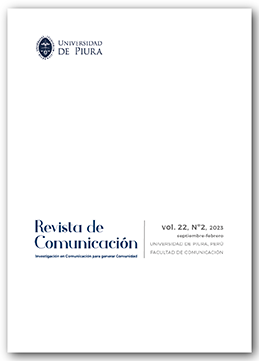Analysis of the impact of the use of clickbait on the Twitter profiles of the Spanish media
DOI:
https://doi.org/10.26441/RC22.2-2023-3233Keywords:
media, social networks, communication, journalism, clickbait, disinformation, TwitterAbstract
The article addresses the use of clickbait in the current media ecosystem, dominated by the hegemony of social networks and in which the competition to attract the attention of users is increasing among the media. In this scenario, one of the challenges that journalism faces is misinformation, but also the challenge of attracting readers to their websites, which is why the use of headlines that seek to attract attention is becoming more and more common. of the user to click on the link, regardless of their informative rigor, which may cause further misinformation. Due to this, this work seeks to analyze the content (messages) that appear in the Twitter profiles of the main Spanish media that use techniques such as clickbait and to evaluate whether the bait headlines produce more misinformation or not, in the current panorama. Spanish media. The methodology is based on the content analysis of the Twitter profiles of Spanish media such as ABC, El País, El Mundo, Público, Diario.es, RTVE Noticias, COPE, Cadena Ser, Onda Cero, Antena 3 Noticias, Noticias Cuatro and La Sexta Noticias. The results indicate that the media analyzed make very little use of this practice and it is mainly concentrated in sections such as Society or Science. It should be noted that, despite making low use of clickbait, the use of other formulas is observed, such as questions in headlines, seeking to attract users and increase the number of page views.
Metrics
References
Aguaded, I. y Romero-Rodríguez, L.M. (2015). Mediamorfosis y desinformación en la infoesfera: Alfabetización mediática, digital e informacional ante los cambios de hábitos de consumo informativo. EKS, abril 2015 vol. 16 nº 1. http://dx.doi.org/10.14201/eks20151614457 DOI: https://doi.org/10.14201/eks20151614457
Bazaco, A., Redondo, M. y Sánchez-García, P. (2019). El clickbait como estrategia del periodismo viral: concepto y metodología. Revista Latina de Comunicación Social, nº74, p. 94-115. https://doi.org/10.4185/RLCS-2019-1323 DOI: https://doi.org/10.4185/RLCS-2019-1323
Cabrera Almeida, S., Vásquez Bohórquez, E.y Barreth González, A. (2023). Medios de comunicación digitales: una nueva forma de ver el periodismo. Polo del Conocimiento, vol. 8, nº 2, p. 994-1007. http://dx.doi.org/10.23857/pc.v8i2.5229
Campos Freire, F., (2008). Las redes sociales trastocan los modelos de los medios de comunicación tradicionales. Revista Latina de Comunicación Social, vol. 11, nº 63, p.277-286. https://www.redalyc.org/articulo.oa?id=81912006023 DOI: https://doi.org/10.4185/RLCS-63-2008-767-287-293
Cision (2015). Social Journalism Study 2015. Cision European & Canterbury Christ Church University (UK)
Flores-Vivar, J. (2009). New models of communication, profiles and trends in social networks. [Nuevos modelos de comunicación, perfiles y tendencias en las redes sociales]. Comunicar, vol. 17, nº 33, p.73-8. https://doi.org/10.3916/c33-2009-02-007 DOI: https://doi.org/10.3916/c33-2009-02-007
Flores-Vivar, J. M. y Zaharía, A. M. (2022). La praxis del clickbait y de The Trust Project: riesgos y retos en los diarios digitales españoles. Anàlisi: Quaderns de Comunicació i Cultura, nº extraordinari 2022, p.5-23. https://doi.org/10.5565/rev/analisi.3463 DOI: https://doi.org/10.5565/rev/analisi.3463
García Orosa, B., Gallur Santorun, S. y López García, X. (2017). El uso del clickbait en cibermedios de los 28 países de la Unión Europea. Revista Latina de Comunicación Social, nº 72, p.1.261-1.277. https://doi.org/10.4185/RLCS-2017-1218 DOI: https://doi.org/10.4185/RLCS-2017-1218
García Serrano, J.; Romero-Rodríguez, L. M.; y Hernando Gómez, A. (2019). Análisis del clickbaiting en los titulares de la prensa española contemporánea / Estudio de caso: Diario El País en Facebook. Estudios sobre el Mensaje Periodístico vol. 25, nº1, p.197-212. http://dx.doi.org/10.5209/ESMP.63724 DOI: https://doi.org/10.5209/ESMP.63724
Herrero-Diz, P. y Pérez-Escolar, M. (2022). Análisis de los bulos sobre covid-19 desmenti- dos por Maldita y Colombiacheck: efectos de la infodemia sobre el comportamiento de la sociedad. Palabra Clave, vol. 25 nº1, e2517. https://doi.org/10.5294/pacla.2022.25.1.7 DOI: https://doi.org/10.5294/pacla.2022.25.1.7
Marín, B. (2019). La tiranía del clic. Turner Publicaciones S.L.
Martínez-Sanz, R. y Arribas-Urrutia, A. (2021). El rol de las redes sociales para futuros periodistas. Manejo, uso y comportamiento de estudiantes y profesores universitarios de Ecuador. Cuadernos.info. nº 49. DOI: http://dx.doi.org/10.7764/cdi.49.27869 DOI: https://doi.org/10.7764/cdi.49.27869
Navarro-Zamora, L. (2009). Tres lustros del periodismo digital: Interactividad e hipertextualidad. Comunicar, vol. 17, nº 33, p.35-43. https://doi.org/10.3916/c33-2009-02-003 DOI: https://doi.org/10.3916/c33-2009-02-003
Palau-Sampio, D. (2016). Metamorfosis de la prensa de referencia en el contexto digital: clickbait y estrategias de tabloide en Elpais.com. Communication & Society, vol. 29, nº2, p.63-80. https://doi.org/10.15581/003.29.2.sp.63-80 DOI: https://doi.org/10.15581/003.29.2.sp.63-80
Pew Research Center (2022) Twitter is the go-to social media site for U.S. journalists, but not for the public (June 27). https://www.pewresearch.org/fact-tank/2022/06/27/twitter-is-the-go-to-social-media-site-for-u-s-journalists-but-not-for-the-public/
Reuters Institute & University of Oxford (2022). Reuters Institute Digital News Report 2022. Reuters Institute for the Study of Journalism. https://reutersinstitute.politics.ox.ac.uk/sites/default/files/2022-06/Digital_News-Report_2022.pdf
Salamea Limones, V., Montecé Mosquera, F. W.; Landeta Bejarano, Z. (2020). Redes sociales y periodismo ciudadano. Journal of Science and Research Vol. 5, N°. 1, enero - marzo 2020. https://dialnet.unirioja.es/servlet/articulo?codigo=7372781
Terol-Bolinches, R. y Alonso-López, N. (2020). La prensa española en la Era de la Posverdad: el compromiso de la verificación de datos para combatir las Fake News. Revista Prisma Social, Nº 31, p.304-327.
Vosoughi, S.; Roy, D. y Aral, S. (2018). The spread of true and false news online. Science, vol. 359, nº 6380, p.1146-1151. https://doi.org/10.1126/science.aap9559 DOI: https://doi.org/10.1126/science.aap9559
Zazo, L. (2022). Análisis de Twitter como herramienta profesional en los entornos políticos y medios de comunicación en España. En Sidorenko, P.; Herranz, J.M.; Terol, R. y Alonso, N. Narrativas emergentes para la comunicación digital, p.486-506. Dykinson.
Zazo, L. (2022). Análisis del mensaje periodístico en Twitter. Información fragmentada y nuevas pautas de consumo. En Mañas, L.; Rivera, P. y Cerdá, M.J. Mediaciones comunicativas, p.581-594. Thomson Reuters Aranzadi.
Zhou, Y. and Cristea, A. I. (2027). Connecting targets to tweets: Semantic attention based model for target-specific stance detection. In Proceedings of the 18th International Conference on Web Information Systems Engineering, springer, 2017, p.18-32. DOI: https://doi.org/10.1007/978-3-319-68783-4_2
Downloads
Published
How to Cite
Issue
Section
License
Copyright (c) 2023 Revista de Comunicación

This work is licensed under a Creative Commons Attribution-NonCommercial-NoDerivatives 4.0 International License.












 Portal de Revistas de la Universidad de Piura.
Portal de Revistas de la Universidad de Piura.